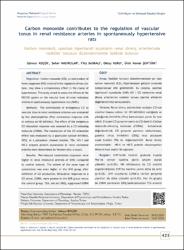| dc.contributor.author | Koçer, Günnur | |
| dc.contributor.author | Nasırcılar, Seher | |
| dc.contributor.author | Basralı, Filiz | |
| dc.contributor.author | Kuru, Oktay | |
| dc.contributor.author | Şentürk, Ümit Kemal | |
| dc.date.accessioned | 2023-11-30T06:55:05Z | |
| dc.date.available | 2023-11-30T06:55:05Z | |
| dc.date.issued | 2020 | en_US |
| dc.identifier.uri | https://www.scopus.com/record/display.uri?eid=2-s2.0-85101583648&origin=resultslist&sort=plf-f&src=s&nlo=&nlr=&nls=&sid=20c4fe371b9b908d4f7e419f791331ff&sot=aff&sdt=cl&cluster=scofreetoread%2c%22all%22%2ct&sl=72&s=AF-ID%28%22Alanya+Alaaddin+Keykubat+University%22+60198720%29+AND+SUBJAREA%28MEDI%29&relpos=164&citeCnt=0&searchTerm= | |
| dc.identifier.uri | https://hdl.handle.net/20.500.12868/2448 | |
| dc.identifier.uri | https://jag.journalagent.com/turkhijyen/pdfs/THDBD-76736-RESEARCH_ARTICLE-KOCER.pdf | |
| dc.description.abstract | Objective: Carbon monoxide (CO), an end product of heme oxygenase (HO) involved in the regulation of vascular tone, may show a compensatory effect in the course of hypertension. This study aimed to assess the effects of the HO/CO system on the vascular tone of renal resistance arteries in spontaneously hypertensive rats (SHRs). Methods: The contribution of endogenous CO to vascular tone in renal resistance arteries was evaluated by the phenylephrine (Phe) contraction response with or without an HO inhibitor. The effect of the exogenous CO relaxation response was assessed by a CO releasing molecule (CORM). The mechanism of the CO relaxation effect was evaluated by a guanylate cyclase inhibitor, ODQ, or a potassium channel blocker, TEA. HO-1 and HO-2 enzyme protein expressions in renal resistance arteries were determined by Western blot analysis. Results: Phe-induced constriction responses were higher in renal resistance arteries of SHRs compared to control animals. The extent of the same type of constriction was even higher in the SHR group after inhibition of CO production. Relaxation responses to a CO donor, CORM, were greater in the SHR group versus the control group. TEA, but not ODQ, suppressed CORM responses in both groups. HO-2 protein expression patterns were not different between the groups, while HO-1 expression was remarkably higher in SHRs when compared to that in control rats. Conclusion: Consequently, our results revealed a CO-based compensatory effect in SHRs by the induction of CO production and an increase in its bioavailability. | en_US |
| dc.language.iso | eng | en_US |
| dc.relation.isversionof | 10.5505/TurkHijyen.2020.76736 | en_US |
| dc.rights | info:eu-repo/semantics/openAccess | en_US |
| dc.subject | CO | en_US |
| dc.subject | HO-1 | en_US |
| dc.subject | SHR | en_US |
| dc.subject | Renal resistance artery | en_US |
| dc.subject | Renal direnç arteri | en_US |
| dc.title | Carbon monoxide contributes to the regulation of vascular tonus in renal resistance arteries in spontaneously hypertensive rats | en_US |
| dc.title.alternative | [Karbon monoksit, spontan hipertansif sıçanların renal direnç arterlerinde vasküler tonusun düzenlenmesine katkıda bulunur] | en_US |
| dc.type | article | en_US |
| dc.contributor.department | ALKÜ | en_US |
| dc.identifier.volume | 77 | en_US |
| dc.identifier.issue | 4 | en_US |
| dc.identifier.startpage | 421 | en_US |
| dc.identifier.endpage | 430 | en_US |
| dc.relation.journal | Turk Hijyen ve Deneysel Biyoloji Dergisi | en_US |
| dc.relation.publicationcategory | Makale - Uluslararası Hakemli Dergi - Kurum Öğretim Elemanı | en_US |


















